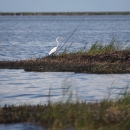The Comprehensive Environmental Response, Compensation, and Liability Act (CERCLA, 42 U.S.C. § 9601 et seq.) and its implementing regulations authorize federal and state agencies to act as trustees of natural resources on behalf of the public. When hazardous substances are released into the environment and harm the public’s natural resources, these trustees conduct assessments to determine the extent of injury, recover monetary and other damages from the responsible parties, and use these recovered damages to plan and implement restoration actions that will compensate the public for the loss of natural resources and the services they would have provided but for the hazardous substance releases. 42 U.S.C. § 9611(i).
The natural resource trustees for the Sugar Creek Valley Natural Resource Assessment Area (SCVAA) are the U.S. Department of the Interior (DOI or Department), acting through the U.S. Fish and Wildlife Service (Service) and the State of Ohio, acting through the Ohio Environmental Protection Agency (Ohio EPA) (collectively referred to as the “Trustees” or the “Trustee Council”). The Trustee Council prepared this Draft Restoration Plan and Environmental Assessment (Draft RP/EA) to identify and evaluate restoration projects at or in the vicinity of the SCVAA that are intended to restore, replace, rehabilitate and/or acquire the equivalent of natural resources and their services injured by releases of hazardous substances from Dover Chemical Corporation (Dover Chemical Corp. or DCC) in Dover, Ohio.
Through the CERCLA Natural Resource Damage Assessment and Restoration (NRDAR) process, the Trustees negotiated a proposed settlement with DCC to restore, replace, rehabilitate and/or acquire the equivalent of natural resources and their associated service losses injured at the SCVAA. The Trustees determined that contamination was present in sufficient quantities to cause injury to ground water, surface water, sediment, and organisms living within, upon, or closely associated with those resources. The releases also adversely affected ecological services provided by injured resources (ground water, surface water, sediment, and related habitat).
Under the National Environmental Policy Act (NEPA; 42 U.S.C. § 4321 et seq.), federal agencies must identify and evaluate environmental impacts that may result from federal actions. This Draft RP/EA describes the purpose and need for restoration, identifies, and evaluates potential restoration alternatives, including a No Action Alternative (Alternative One), summarizes the affected environment, and describes the potential environmental consequences of proposed restoration activities negotiated with DCC.
The restoration projects focus on restoring the types of natural resources at and in the vicinity of the SCVAA. Public review of the restoration alternatives is an integral and important part of the restoration planning process and is consistent with applicable state and federal laws and regulations. Thus, the Trustees are soliciting comments on this Draft RP/EA and will address any public comments received in a Final RP/EA. For additional information on the terms of the proposed settlement, please see United States of America and State of Ohio v. Dover Chemical Corporation. The Consent Decree (CD) is currently available for public review and comment on the Department of Justice website.
The proposed restoration projects include ground water recharge protection, habitat improvement and preservation within the Sugar Creek watershed, and preservation or enhancement of habitat including stream, riparian riparian
Definition of riparian habitat or riparian areas.
Learn more about riparian , wetland, and mature forest environments outside the watershed to benefit trust resources. Three Alternatives will be presented in this Draft RP/EA and will be evaluated using NRDAR and NEPA criteria.
Specifically, the three Alternatives include:
- Alternative One: No Action /Natural Recovery Alternative
- Alternative Two: Acquisition, preservation, restoration, or enhancement of high-quality habitat and Trustee implemented ground water protection project(s):The Wilderness Center – Falcon Flats Restoration Project
- The Wilderness Center – Lash’s Bog Enhancement and Restoration
- Sugar Creek Habitat Conservation Project
- Western Reserve Land Conservancy – Eastern Hellbender Project
- Future Ground Water Restoration/Protection Project (Trustee implemented, to be determined)
- Alternative Three: Acquisition and restoration of habitat and well head protection, including the following projects:
- Joyce Hill Road SW Property Ground Water Recharge Project
- The City of Dover Wellhead Protection/ Soccer Field Protection Project
- The City of Dover Canal Park Restoration and Enhancement Project



